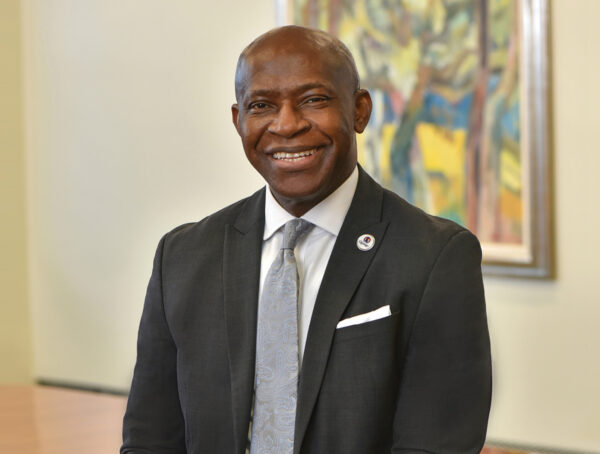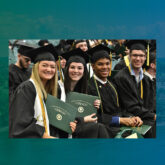When Margaret “Peggy” La Tulip Focarino ’77 was a fifth grader in the ’60s, most girls her age wanted Barbie dolls or Easy-Bake ovens. She asked her parents for a telescope.
The little girl who so loved science and discovery became the only woman majoring in physics during her time at SUNY Oswego. And she’s still breaking new ground.
In January, Focarino made history when she took office as the first female Commissioner of Patents in the U. S. Patent and Trademark Office’s 222-year history.
The focus and vision the star-gazer exhibited at an early age serves her well as she leads a massive federal agency, with an annual budget of $2.17 billion and a highly educated, diverse workforce numbering more than 10,000.
Directly across from her desk in her 10th floor office overlooking the USPTO’s modern campus in Alexandria, Va. — the very first thing she placed in her new office as commissioner — hangs Patent No. 3,114,204, granted to her grandfather, Joseph La Tulip of Oswego, N.Y. He registered a safe razor blade disposal system in 1963, and she looks often at that family heirloom to remind her of just why she’s there.
“Our mission is to encourage innovation and invention,” she says. “That ultimately creates jobs, contributing to economic recovery.”
She refers to the USPTO as the “Innovation Agency,” calling its role in generating commerce “extremely critical for the country.”

There’s a personal sense of accomplishment, too. “It’s very satisfying when you see something you’ve granted a patent on,” says Focarino, who early in her career examined patents for solar technology, heating and cooling systems and combustion systems. She points out that everything people use in their daily lives — from safety pins to shoes to smart phones — had their origins in some inventor’s dreams.
In fact, walking into the USPTO’s Madison Building, a towering edifice of brick, glass and steel with Focarino’s office at the peak of a dazzling atrium, a visitor can’t miss the message. In January, a massive display of just a selection of the late Apple CEO Steve Jobs’ 323 patents filled the floor, arrayed on 30 giant replicas of the iPhone.
To the right of the entrance is the National Inventor’s Hall of Fame museum, this year focusing on fitness. Exercise guru Jack LaLanne’s leotard and juicer are on display, along with artifacts including John Harvey Kellogg’s original light box and “vibratory chair” from his Battle Creek Sanitarium; designs for the ThighMaster and Nike waffle-sole running shoe, and penny scales that give both weight and fortune.
Talking portraits (a la the Harry Potter movies) of Thomas Jefferson, James Madison, medical self-testing pioneer Helen Free, Thomas Edison and Apple co-founder Steve Wozniak recite a history of the USPTO, founded in Article 1, Section 8 of the U. S. Constitution. In his role as Secretary of State, Thomas Jefferson was the first Commissioner of Patents, and he carried applications home to study, storing them under his bed, thereby giving rise to the name “shoes,” given to the USPTO’s former cataloguing drawers for patent applications.
MORE: This is your day … on patents
Eye on the Future
For all its history, the Patent Office is a forward-looking institution, and no one recognizes that more than Commissioner Focarino.
“We are part of something that has a long history, but also a tremendous future,” she says.
“Although we are steeped in history … we are pushing the envelope, always trying to do better. We are not content to keep things running, we must continue to make things better.”
Making things run better comes naturally for Focarino, who rose through the ranks at the agency, garnering respect both for her knowledge and her personal style.
MORE: View Peggy’s career highlights
When Focarino began as a patent examiner in 1977, straight out of SUNY Oswego, women examiners were few in number and she met with her share of opposition. Not as much as famed battlefield nurse Clara Barton, who as a confidential clerk to the commissioner of patents in 1854 was the first woman to be paid the same as male employees, causing them to blow smoke in her face and spit tobacco juice in her direction.
Focarino met with more subtle resistance. An avid bowler since the time she was big enough to hold a bowling ball, she wanted to join the agency league in the late ’70s to meet people and make new friends. Some of the men quit the league, one citing the fact that “his wife wouldn’t approve” of him bowling with a woman.
The workforce Focarino leads now is much more diverse. More than 7,000 examiners represent virtually every segment of the population. A Community Day

Peggy La Tulip Focarino ’77 poses with an exhibit recognizing the patents of the late Apple CEO Steve Jobs.
celebration each year recognizes their vibrant diversity.
A young and highly educated employee base — most have science, math or engineering degrees — they face modern challenges like isolation as they work remotely or spend long stretches in front of computers instead of physically tracking down paperwork and sketches.
“Our collaboration tools are robust,” Focarino said, with many ways for examiners to stay connected, including instant messaging, video conferencing and computer chatting.
‘Culture of Collaboration’
Another area in which she broke ground is that of labor-management relations. When Focarino was deputy commissioner, the USPTO’s director, Under Secretary of Commerce for Intellectual Property, David Kappos, gave her the authority to work directly with the Patent Office Professional Association on several major issues with a decades-long adversarial history.
“Peggy created an entirely different environment,” says Robert D. Budens, POPA president. “She took what we had for many years — a culture of conflict — and turned it into a culture of collaboration.”
He attributes this success in part to Focarino’s personality and in part to her willingness to listen and work together to achieve a win-win outcome. “She is very intelligent and an excellent manager and has a great command of the big picture and the things that need to be done,” says Budens. “She is also willing to listen to us and the issues that we bring to the table when negotiating.
“Peggy came in with a desire to work with us and listen to us — and we came in with the same desire. It has grown into a good healthy relationship for the agency,” he says.
The collaborators achieved major success on two fronts: the Count System Initiatives, which set out how examiners get credit for the work they do, and the Examiner Performance Appraisal system, the latter just put into place in October.
Labor and management had struggled over the appraisal system since it was mandated by the Civil Service Reform Act of 1978, back in the Carter administration. Their lack of agreement saw them arguing before the Federal Services Impasses Panel, the Federal Labor-Relations Authority, and eventually all the way to the U.S. Court of Appeals for the District of Columbia circuit.
When Focarino and her management team sat down with Budens and his labor team, they ironed out an agreement, ending three decades of disagreement in a matter of months.
Their success attracted the attention of researchers from the Georgetown University McDonough School of Business. Dr. Brooks Holton and his MBA students  are working on a case study of the USPTO labor/management achievements.
are working on a case study of the USPTO labor/management achievements.
Focarino’s management goal is to make herself accessible to everyone, holding “town hall” meetings where examiners can share their ideas and the roadblocks they see to agency goals, like reducing the backlog of patent applications.
It’s an area where the agency has faced major criticism. There are more than 1.2 million pending patents, with about 660,000 applications still awaiting first examination. Currently it takes an average of 33 months for a patent application to reach approval, and in some particularly busy areas, even longer. It takes 24 months on average for an inventor to receive a first response to an application. Focarino’s goal is to get that down to 10 months within three years. To that end, the agency is hiring more examiners and attempting to keep attrition levels low.
Focarino is also trying another approach: fun. On the door of her office hangs a poster for the Tour de Copa, a race-like competition to encourage employees to cut down the backlog.
Focarino uses modern technology to increase efficiency and transparency at the agency. Training programs for examiners can be accessed online as can a dashboard of agency statistics, all information available instantly to the user community — inventors, patent attorneys and the like.
She spends her days in face-to-face meetings with her own senior staff members. She also meets with staffers from Capitol Hill, heads of other agencies and her counterparts in other countries as they seek to codify intellectual property laws around the world.
“She goes beyond managing, she is a leader,” Budens says of Focarino. Morale is higher and employees are working in a less stressful environment than in times past.
Out of 260 federal agencies, the Patent Office ranked as the 19th best place to work. “My goal is to make us No. 1,” Focarino says.
Fascination with physics
Focarino credits her high school physics teacher, Mike Goldych, with sparking her love of the subject. He was a brand new teacher when she entered Oswego High School. “He really knew how to connect with the students and I fell in love with the subject because of his ability to explain it,” she recalls.
At SUNY Oswego, Dr. John O’Dwyer became a big influence on Focarino with his “wonderful, fatherly way” of leading the tiny physics department and its eight majors. Physics Professor Dale Zych and Professors Emeriti Ram Chaudari and Paul Liebenauer were new to the faculty and made a positive impression on the department’s only female student.
Now she hopes to instill a love of science and technology in the next generation, lest America find itself “woefully behind the rest of the world.”
“Kids idolize sports figures. We need to get them to idolize people who invent things and entrepreneurs,” she says. “The history of our country is built on invention, innovation — we have to keep that going.”
She points to a photo of President Barack Obama signing the America Invents Act in September at Thomas Jefferson High School for Science and Technology. The bill will give the USPTO the funding it needs to hire more examiners to trim the backlog of patent applications and is the biggest legislation to affect invention and innovation since the Patent Act of 1952.
Where the new law and the new commissioner’s vision will take the agency and the U. S. economy remains to be seen. There’s no telescope that can bring the future into clear focus. At least, one hasn’t been invented … yet.
You might also like
More from Featured Content
Vision for the Future
VISION for the Future Peter O. Nwosu began his tenure as the 11th president of SUNY Oswego, building on the solid …
Envisioning the Potential in All Students
ENVISIONING the Potential in All Students Educator donates $2 million in recognition of his Oswego education, in support of future teachers Frank …
A Vision of Support
A VISION of Support Award-winning principal makes an impact on her school through her positivity and commitment When Nicole Knapp Ey ’02 …











